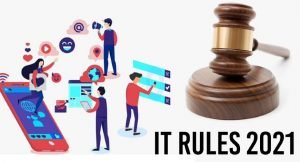The Ministry of Electronics and Information Technology (MeitY) came up with the Intermediary Guidelines and Digital Media Ethics Code, 2021 (“IT Rules”) in February last year and it came into effect in May, 2021.
After a year of its enforcement, MeitY has come up with the Draft IT Amendment Rules on 6th June, 2022 after initially withdrawing it on 2nd July, 2022 and re-uploading it later.
These rules have presently been put up in public domain for inviting comments from various stakeholders as a part of pre-legislative consultation process as per the Government of India.
“These are being offered for public consultation and comments from all stakeholders for the next 30 days. A formal public consultation meeting will be arranged by and the details will be notified soon”
–Press Note (MEITY, Government of India)
These Draft IT Rules majorly seeks to provide additional avenues for grievance redressal apart from Courts by providing for an additional forum in the form of creation of Grievance Appellate Committee.
Further, emphasis has been given on the speedy compliance of the Grievance Redressal Mechanism by putting in place a shorter timeline in dealing with user grievances as the amendment proposes that intermediaries respond to requests for removal within 72 hours.
Further as per the preamble to the Draft Rules, special weight has been given on putting the interests of ‘digital Indians’ first, the proposed amendments aim to ‘ensure that the Constitutional rights of Indian citizens are not contravened by any Big-tech Platform.’ An important and categorical addendum to this preamble: the Rules ‘will not impact early stage or growth stage Indian companies or Startups.’ Among other things, they suggest that intermediaries strictly enforce user agreements and content moderation regulations—while allowing users to appeal potential takedowns of their information before an Executive-appointed Committee.
The IT Rules, 2021 have seen their fair share of controversies since its advent as various litigations challenging the constitutional validity of these rules have been instituted all across the country and are pending.
KEY PROPOSED AMENDMENTS
Creation of a Grievance Redressal Committee
Any person aggrieved by an order made by the Grievance Officer, may prefer an appeal to the Grievance Appellate Committee as per Rule 3(3) of the Draft Rules.
According to the amendment, a user can appeal a GO’s order to the Grievance Appellate Committee within 30 days of receipt of a GO’s order, and the Grievance Appellate Committee would have to ‘endeavour’ to resolve it within another 30 days of receiving the appeal from the user, the amendment said.
This committee will also have the power to overrule any decision made by grievance officers of intermediaries, including blocking or removal of any user or user account on social media platforms. It is an alternative to approaching the Courts for grievance redressal. Given the current wording of the Rules, it oversees all intermediaries as defined under the IT Act, 2000.
Lack of Authority for Creation of a Committee?
Further as far as the Constitution of the Committee is concerned, there is no specific clarity with respect to the appointment or designation of the Chairperson and other members. Substantive legal changes, such as the creation of such a committee, need to happen under the parent legislation, [that is, the] IT Act, 2000. They cannot be enacted through subsidiary rules like the IT Rules 2021.
In any case, there is no text in the Rules on the nature of the Committee itself—on how it will redress complaints, on transparency, or on the procedure. So, in its current form, the GAC has a substantive impact on a user’s Fundamental Rights, without elaborating on [procedure or] how it may impact them.[i]
Revised Deadlines for addressing grievances of users
The Draft Rules proposes through amendments to Rule 3(2) directing Grievance Officers to expeditiously dispose of complaints. This amendment is put into place to ensure that any complaint for removal of any content under rule 3(1)(b) has be addressed within 72 hours of the receipt of the user’s complaint.
This is majorly done because of the very nature of cyber space providing instant communication, outreach and virality. Any other grievance will continue to be addressed within 15 days. This will help to ensure that problematic content is removed expeditiously, and does not become viral over a sustained period of time.
Enforcing constitutional rights through intermediaries
The Draft Rules has proposed to add Rule 3(1)(m) and 3(1)(n) which shall require intermediaries to respect the rights guaranteed to users under the Constitution of India and ensure accessibility of its services to users along with reasonable expectation of due diligence, privacy and transparency. A closer look at this rule would hint towards the ‘horizontal application’[ii] of constitutional rights.
The provision is vaguely worded and there is no certainty on the import of the word “accessibility” and “transparency” used in the provision. Further, the exact scope of obligation is left in the grey. The inclusion of privacy obligations (that too ill defined here) is unnecessary as there is already separate IT Rules governing that aspect. The Data Protection Bill is also under deliberation which shall regulate the privacy concerns of individuals.
The government cites the rationale for such an amendment to be necessary because a number of Intermediaries have acted in violation of constitutional rights of Indian citizens and keeping in mind that Government is the guarantor of such rights of all our citizens. The intent is in the right direction but the provision of law to the effect is not concrete.
Ensuring the compliance of user terms and agreements
The new amendments endeavour to require intermediaries to ensure that users comply with requirements in rule 3(1)(a) and rule 3(1)(b) of the IT Rules 2021. The touted objective by the regulators is that; while intermediaries may additionally create their own community standards as per their business policies, the proposed amendment to the IT Rules 2021 specifically require them to enforce the rule 3(1)(b) in the larger interest of the safety and trust while also making the intermediaries accountable. This will ensure actual enforcement of the requirements in the IT Rules 2021 in letter and spirit.
However, a closer look at the word of Rule 3(1)(b) would reflect a glaring practical difficulty for intermediary platforms which are ‘public facing’. The cloud service providers, video conferencing apps, private messaging platforms, are not ‘public facing’ platforms, i.e., the user content on the platforms are not visible to the public. The usage of the word “…..shall “cause” the user of its computer resource not to host, display, upload, modify, publish, transmit, store, update or share any information..” will not be a practical approach for two-way communication platform which are private. There is no control of intermediary on content shared here and therefore through technology means it cannot “cause” the user to comply. At the best, it can notify the user in terms and conditions which is already available. There is more requirement of the exact application of the word “cause”.
On the flip side, as far as copyright owners are concerned this pre-censorship provision would be beneficial to them as intermediaries would need to have filtrations in place to ensure pirated content is not uploaded. For instance, currently short video format applications which have user generated content don’t put any filtrations in place to ensure that users don’t put copyrighted content. They simply take it down if they receive a takedown notice.
CONCLUDING REMARKS
In today’s digital age, social media has become all-powerful. The need to regulate content and have good policy measures in light of the instances of communal rifts and public order issues arising in the country is paramount. The stapled objective of the proposed amendment is well in place, however, it lacks foreseeability on effective and practical enforcement in some aspects, as highlighted above. The proposed Draft IT Rules need to strike a balance between free speech and regulation. Further, the words and their true import in legal provisions need to be defined with certainty, especially in policies that shall have a large impact on people as well as businesses.
References:
[i] Aarathi Ganesan, Medianama, 22nd July, 2022, Available at: Experts flag free speech and self-censorship in India’s amended IT Rules (medianama.com).
[ii] Stephen Gardbaum, The Indian Constitution and Horizontal Effect, May 2015, Oxford Handbook of the Indian Constitution, Sujit Choudhry, Madhav Khosla and Pratap Mehta eds., Oxford University Press, 2016, Available at: https://papers.ssrn.com/sol3/papers.cfm?abstract_id=2601155
Image source: here



















